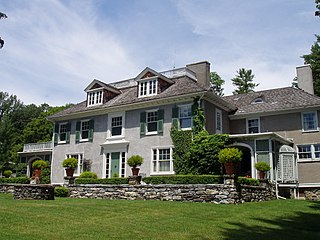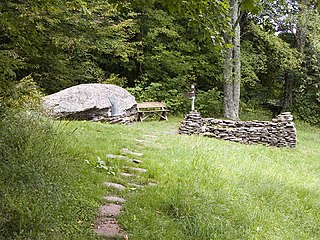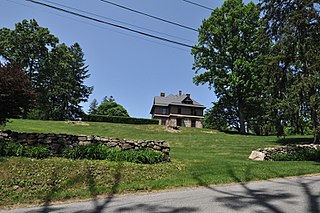
Saint-Gaudens National Historical Park in Cornish, New Hampshire, preserves the home, gardens, and studios of Augustus Saint-Gaudens (1848–1907), one of America's foremost sculptors. This was his summer residence from 1885 to 1897, his permanent home from 1900 until his death in 1907, and the center of the Cornish Art Colony. There are two hiking trails that explore the park's natural areas. Original sculptures are on exhibit, along with reproductions of his greatest masterpieces. It is located on Saint-Gaudens Road in Cornish, 0.5 miles (0.80 km) off New Hampshire Route 12A.

Buildings, sites, districts, and objects in Virginia listed on the National Register of Historic Places:

The Chrysler Museum of Art is an art museum on the border between downtown and the Ghent district of Norfolk, Virginia. The museum was founded in 1933 as the Norfolk Museum of Arts and Sciences. In 1971, automotive heir, Walter P. Chrysler Jr., donated most of his extensive collection to the museum. This single gift significantly expanded the museum's collection, making it one of the major art museums in the Southeastern United States. From 1958 to 1971, the Chrysler Museum of Art was a smaller museum consisting solely of Chrysler's personal collection and housed in the historic Center Methodist Church in Provincetown, Massachusetts. Today's museum sits on a small body of water known as The Hague.

The Frank Lloyd Wright Home and Studio is a historic house and studio in Oak Park, Illinois from 1889, owned by architect Frank Lloyd Wright. This is his only home designed for a person with a disability. This home is fully furnished with all original Wright-designed furniture and textiles. It has been restored by the Frank Lloyd Wright Preservation Trust to its appearance in 1909, the last year Wright lived there with his family. Wright developed his career and aesthetic to become one of the most influential architects of the 20th century. The property was listed on the National Register of Historic Places in 1972, declared a National Historic Landmark four years later, and contributes to the Frank Lloyd Wright–Prairie School of Architecture Historic District containing a number of his projects and related work.

Augusta Savage was an American sculptor associated with the Harlem Renaissance. She was also a teacher whose studio was important to the careers of a generation of artists who would become nationally known. She worked for equal rights for African Americans in the arts.

Chesterwood was the summer estate and studio of American sculptor Daniel Chester French (1850–1931) located at 4 Williamsville Road in Stockbridge, Massachusetts. Most of French's originally 150-acre (61 ha) estate is now owned by the National Trust for Historic Preservation, which operates the property as a museum and sculpture garden. The property was designated a National Historic Landmark in 1965 in recognition of French's importance in American sculpture.

The Fisher Fine Arts Library was the primary library of the University of Pennsylvania from 1891 to 1962. The red sandstone, brick-and-terra-cotta Venetian Gothic giant—part fortress and part cathedral—was designed by the acclaimed Philadelphia architect Frank Furness (1839–1912). The cornerstone was laid in October 1888, construction was completed in late 1890, and the building was dedicated in February 1891.

The Whitney Museum of American Art original building is a collection of three 1838 rowhouses located at 8–12 West 8th Street between Fifth Avenue and MacDougal Street in the Greenwich Village neighborhood of Manhattan, New York City. In 1907, Gertrude Vanderbilt Whitney established the Whitney Studio Gallery at 8 West 8th Street adjacent to her own MacDougal Alley studio. This, and the later Whitney Studio Club at 147 West 4th Street, were intended to provide young artists with places to meet and exhibit their works.

Woodchuck Lodge is a historic house on Burroughs Memorial Road in a remote part of the western Catskills in Roxbury, New York. Built in the mid-19th century, it was the last home of naturalist and writer John Burroughs (1837-1921) from 1908, and is the place of his burial. The property is now managed by the state of New York as the John Burroughs Memorial State Historic Site, and the house is open for tours on weekends between May and October. The property is a National Historic Landmark, designated in 1962 for its association with Burroughs, one of the most important nature writers of the late 19th and early 20th centuries.

The Frederic Remington House is a historic house at 36 Oak Knoll Road in Ridgefield, Connecticut. A National Historic Landmark, it was the home of the painter and sculptor Frederic Remington (1861–1909) in the last few months of his life. Remington and his wife designed the two-story gambrel-roofed, fieldstone-and-shingle house. He produced some of his finest work in the house including the sculpture "The Stampede" and the painting "The Love Call". The house was declared a National Historic Landmark in 1965.

C. M. Russell Museum Complex is an art museum located in the city of Great Falls, Montana, in the United States. The museum's primary function is to display the artwork of Great Falls "cowboy artist" Charles Marion Russell, for whom the museum is named. The museum also displays illustrated letters by Russell, work materials used by him, and other items which help visitors understand the life and working habits of Russell. In addition, the museum displays original 19th, 20th, and 21st century art depicting the American Old West and the flora, fauna, and landscapes of the American West. In 2009, the Wall Street Journal called the institution "one of America's premier Western art museums." Located on the museum property is Russell's log cabin studio, as well as his two-story wood-frame home. The house and log cabin studio were designated a National Historic Landmark in 1965, and added to the National Register of Historic Places in 1966. In 1976, the listing boundaries were amended to account for moving the house.

The A. J. Mason Building is a single-story brick building that is the only remaining original structure in Tullahassee, Oklahoma. The building was listed on the National Register of Historic Places August 5, 1985.

The Stephen Vincent Benét House, commonly referred to as Benét House, is a historic house on the Summerville campus of Augusta University in Augusta, Georgia. The house was built 1827–29 as the Commandant's House of the Augusta Arsenal, and is a much-altered example of Federal period architecture. The house was designated a National Historic Landmark in 1971 for its association with the Pulitzer Prize-winning writer Stephen Vincent Benét (1898–1943), who lived here in the 1910s. The house, which housed the official residence of the Augusta State University for a time, presently houses the Summerville campus's office of admissions.

The Woodrow Wilson Boyhood Home is a historic house museum at 419 7th Street in Augusta, Georgia. Built in 1859, it was a childhood home of Woodrow Wilson (1856–1924), the 28th president of the United States and proponent of the League of Nations. The house is owned and operated by Historic Augusta, Inc., and was designated a National Historic Landmark on October 6, 2008.

The Broad Street Historic District in Augusta, Georgia is a 70 acres (28 ha) historic district that was listed on the National Register of Historic Places (NRHP) in 1980. It includes 158 contributing buildings.

The Dorilton is a luxury residential housing cooperative in Manhattan, New York City. Construction began in 1900 and was completed by 1902.

Stonecrest is a historic home located at Bedford Corners, Westchester County, New York. It was built in 1879 in an eclectic Stick-Eastlake style and renovated in 1916. It is a rectangular three-story dwelling, measuring 50 feet deep and 45 feet wide. The first story is built of random rubble and the second of wood shingles that flare away from the first floor. A slate covered hipped roof covers the third floor and attic. Also on the property are a contributing Stick Style carriage house, stone root cellar, and stone spring house.

Major General George Henry Thomas, also known as the Thomas Circle Monument, is an equestrian sculpture in Washington, D.C. that honors Civil War general George Henry Thomas. The monument is located in the center of Thomas Circle, on the border of the downtown and Logan Circle neighborhoods. It was sculpted by John Quincy Adams Ward, best known for his work on the statue of George Washington in Wall Street, Manhattan. Attendees at the dedication in 1879 included President Rutherford B. Hayes, Generals Irvin McDowell, Philip Sheridan, and William Tecumseh Sherman, senators and thousands of soldiers.

Cony Flatiron is a historic school building at Cony and Stone Streets in Augusta, Maine. Built between 1926 and 1932 and the high school building, along with the catwalk was demolished in 2008, it is locally unusual for its flatiron shape, and its social history as the city's third high school building. It was listed on the National Register of Historic Places in 1988.

Lift Every Voice and Sing, also known as The Harp, was a plaster sculpture by African-American artist Augusta Savage. It was commissioned for the 1939 New York World's Fair, and displayed in the courtyard of the Pavilion of Contemporary Art during the fair at Flushing Meadow. The sculpture was destroyed along with other temporary artworks at the site after the closing of the exhibition in 1940.























